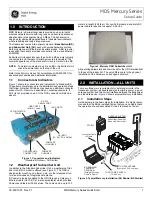
16
CONNECTIONS
Digital audio
The AVR 760/AVR 660 is equipped with four HDMI (High-Definition
Multimedia Interface) inputs, and one output. HDMI technology enables
digital audio and video information to be carried using a single cable,
delivering the highest quality picture and sound.
The AVR 760/AVR 660 uses HDMI (V.1.3a with Deep Color) technology and
is capable of processing both the audio and video components of the HDMI
data, minimizing the number of cable connections in your system. The
AVR 760/AVR 660 implements Deep Color, which increases by an order of
magnitude the shades of color that can be displayed, and the latest lossless
multichannel audio formats, including Dolby TrueHD and DTS-HD Master
Audio.
NOTE
: Some DVD-Audio, SACD, Blu-ray Disc and HD-DVD players only
output multichannel audio through their multichannel analog outputs.
Make a separate analog audio connection in addition to the HDMI
connection, which is still used for video and to listen to Dolby Digital, DTS
or PCM materials that may be stored on the disc.
The AVR 760/AVR 660 converts analog video signals to the HDMI format,
including its on-screen menus, upscaling to high-definition 1080p resolution.
The HDMI connector is shaped for easy plug-in (see Figure 4). If your video
display has a DVI input and is HDCP-compliant, use an HDMI-to-DVI adapter
(not included). A separate audio connection is required. HDMI cable runs are
limited to about 3 meter.
Figure 4 – HDMI Connection
If your video display or source device is not HDMI-capable, use one of the
analog video connections (composite, S- or component video) and a separate
audio connection.
Coaxial digital audio jacks are usually color-coded in orange. Although they
look similar to analog jacks, you should not connect coaxial digital audio
outputs to analog inputs or vice versa. See Figure 5.
Coaxial
Coaxial digital
audio cable
Figure 5 – Coaxial Digital Audio
Optical digital audio connectors are normally covered by a shutter to protect
them from dust. The shutter opens as the cable is inserted. Input connectors
are color-coded using a black shutter, while outputs use a gray shutter. See
Figure 6.
Optical
Optical digital
audio cable
Figure 6 – Optical Digital Audio
analog audio
Analog connections require two cables, one for the left channel (white) and
one for the right channel (red). These two cables are often attached to each
other. See Figure 7.
For sources that are capable of both digital and analog audio, you may make
both connections.
The analog audio connection is required for multizone operation, as the
AVR 760/AVR 660’s multizone system is not capable of converting a digital
signal to analog format. Use the analog audio connections even with the
Surround Back/Zone 2 speaker outputs, in case another 2-channel digital
audio source is in use in the main listening area. The AVR 760/AVR 660 is only
capable of processing one PCM source at a time.
You may only record materials from DVDs or other copy-protected sources
using analog connections. Remember to comply with all copyright laws, if
you choose to make a copy for your own personal use.
Analog audio
cable (RCA)
L
R
Figure 7 – Analog Audio
Multichannel analog connections are used with high-definition sources that
decode the copy-protected digital content, such as some DVD-Audio, SACD,
Blu-ray Disc and HD-DVD players. See Figure 8. The multichannel analog
audio connection is not required for players compliant with HDMI version 1.1
or better, or that output linear PCM signals via an HDMI connection. Consult
the owner’s guide for your disc player for more information.
Multichannel
analog audio
cable (RCA)
Front
Surround
Center
White
Blue
Green
Red
Gray
Purple
Subwoofer
Figure 8 – Multichannel Analog Audio
The AVR 760/AVR 660 also includes a proprietary, dedicated audio connection
for The Bridge II docking station for iPod. If you own a docking iPod (most
models, 4G or later), connect The Bridge II (included) to The Bridge II port on
the receiver. See Figure 9. Dock your iPod (not included) in The Bridge II, and
you may listen to your audio materials through your high-performance audio
system. You may view still images or video materials stored on a photo- or
video-capable iPod that supports video browsing. Use the AVR 760/AVR 660
remote to control the iPod, with navigation messages displayed on the front
panel and on a video display connected to the AVR. The Bridge II outputs
analog audio to the AVR 760/AVR 660, and is available to the multiroom
system.
THE BRIDGE
Figure 9 – The Bridge II port
















































